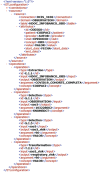TransformEHRs: a flexible methodology for building transparent ETL processes for EHR reuse
- PMID: 36220109
- PMCID: PMC9788916
- DOI: 10.1055/s-0042-1757763
TransformEHRs: a flexible methodology for building transparent ETL processes for EHR reuse
Abstract
Background: During the COVID-19 pandemic, several methodologies were designed for obtaining electronic health record (EHR)-derived datasets for research. These processes are often based on black boxes, on which clinical researchers are unaware of how the data were recorded, extracted, and transformed. In order to solve this, it is essential that extract, transform, and load (ETL) processes are based on transparent, homogeneous, and formal methodologies, making them understandable, reproducible, and auditable.
Objectives: This study aims to design and implement a methodology, according with FAIR Principles, for building ETL processes (focused on data extraction, selection, and transformation) for EHR reuse in a transparent and flexible manner, applicable to any clinical condition and health care organization.
Methods: The proposed methodology comprises four stages: (1) analysis of secondary use models and identification of data operations, based on internationally used clinical repositories, case report forms, and aggregated datasets; (2) modeling and formalization of data operations, through the paradigm of the Detailed Clinical Models; (3) agnostic development of data operations, selecting SQL and R as programming languages; and (4) automation of the ETL instantiation, building a formal configuration file with XML.
Results: First, four international projects were analyzed to identify 17 operations, necessary to obtain datasets according to the specifications of these projects from the EHR. With this, each of the data operations was formalized, using the ISO 13606 reference model, specifying the valid data types as arguments, inputs and outputs, and their cardinality. Then, an agnostic catalog of data was developed through data-oriented programming languages previously selected. Finally, an automated ETL instantiation process was built from an ETL configuration file formally defined.
Conclusions: This study has provided a transparent and flexible solution to the difficulty of making the processes for obtaining EHR-derived data for secondary use understandable, auditable, and reproducible. Moreover, the abstraction carried out in this study means that any previous EHR reuse methodology can incorporate these results into them.
The Author(s). This is an open access article published by Thieme under the terms of the Creative Commons Attribution-NonDerivative-NonCommercial License, permitting copying and reproduction so long as the original work is given appropriate credit. Contents may not be used for commercial purposes, or adapted, remixed, transformed or built upon. (https://creativecommons.org/licenses/by-nc-nd/4.0/).
Conflict of interest statement
None declared.
Figures




References
-
- Häyrinen K, Saranto K, Nykänen P. Definition, structure, content, use and impacts of electronic health records: a review of the research literature. Int J Med Inform. 2008;77(05):291–304. - PubMed
-
- Parra-Calderón C L, Sanz F, McIntosh L D.The challenge of the effective implementation of FAIR principles in biomedical research Methods Inf Med 202059(4-05):117–118. - PubMed

